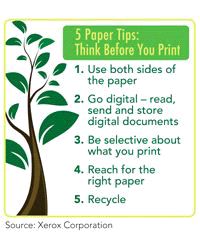Consumables
Five Paper Tips from Xerox: Use Less, Use Wisely

Thursday 01. May 2008 - Memos, reports, invoices, forms, presentations and instructions are the trademark of a busy office - and signal the vital role paper plays in it every day. Yet Xerox Corporation (NYSE: XRX) studies show that office workers throw away 45 percent of documents within 24 hours of printing them.
How can you stay productive while using resources wisely?
Paper is a renewable resource. If you think before you print and choose the paper that’s right for the job, you can reduce the environmental footprint of your office. As one of the world’s largest suppliers of papers for office printers and copiers, Xerox is sharing five simple tips for smart paper use.
Use both sides of the paper. It’s called “duplex printing” and it is the single best way to reduce paper use. So choose copiers, digital printers and multifunction devices that can print on both sides of the paper. Add duplex as your “default” mode.
Go digital. Save on postage by sending electronic files and let your recipient decide whether to print them. Replace paper files with electronic ones using the scan-to-file option on multifunction devices.
Be selective: Print what you need when you need it. For example, print only the portion of the report you need, not every page. Preview your print to avoid printing pages with boilerplate. Print on demand. Don’t stockpile forms, letterhead, or instructions that will go out of date.
Reach for the right paper. A number of options promote sound environmental practices. For instance, Xerox High Yield Business Paper is produced using half the number of trees of conventional paper. Print on papers certified through global organizations, such as the Forest Stewardship Council or the Programme for the Endorsement of Forest Certification, both of which have strict international standards for sustainable forestry. Or use paper with recycled content.
Recycle. Collect used paper so the fiber can be used again. Recycling the fiber saves trees, reduces energy and water use, requires fewer chemicals, and keeps paper out of landfills.
“It may be a surprise that Xerox is concerned about excessive paper use. After all, we’re in the business of putting marks on pages,” said Wim Appelo, president, Xerox Strategic Services, which manages Xerox’s paper business as well as its company-wide environmental programs.
“But, the hallmark of our business has always been operating in an environmentally responsible way. That means holding our suppliers to tough standards on how they make paper, improving forest management and protecting endangered forests. As important, through Xerox innovation we help our customers minimize their impact on the environment while meeting their business needs.”
Xerox applies stringent requirements on all its paper suppliers and is working with The Nature Conservancy to identify and promote best practices that will enable environmental scientists, forest managers and paper suppliers to work cooperatively toward sustainable forest management. Long an evangelist for greener operations, Xerox believes that environmental sustainability isn’t a cost of doing business, but a way of doing business that benefits shareholders, customers, employees and the world in which we work and live.
